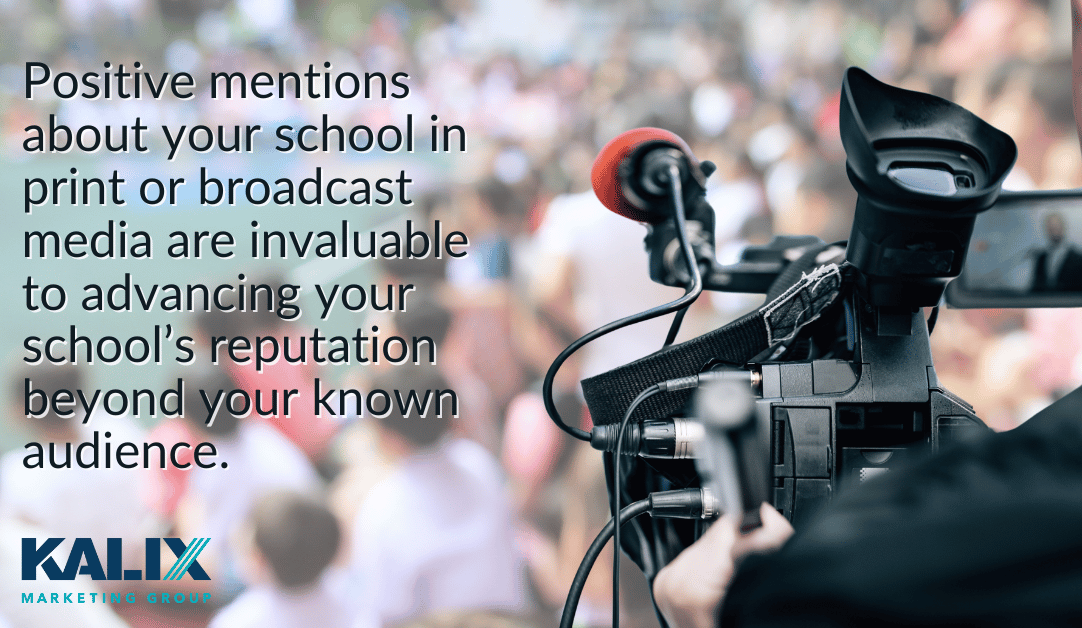Every independent school wants positive media coverage about its programs, students and faculty. Even in today’s social-media-dominated landscape, what the press says about your school is important to your current communities and to introducing whole new audiences to your school.
Getting the attention of news outlets can be challenging, though. In this three-part series, I will share my press relations experience, along with tried-and-true tips to help improve your school’s media strategy and success.
Print isn’t dead. Media coverage and positive mentions about your independent school in print or broadcast mode still help move the needle for your school’s awareness and enrollment goals.
Positive mentions about your school in print or broadcast media (earned media) are invaluable to building better word of mouth and advancing your school’s reputation beyond your known audiences.
But with fewer and fewer press outlets and most school communications teams understaffed and overworked, how is your school supposed to get the press’ attention? It’s not easy, but it’s not impossible.
In this post, I break down exactly what you need to know to get the press coverage your school needs and deserves. First, let’s dig into why it’s worth the effort.
What’s the Pay-off of Press Coverage in Media?
The goal of any media is to attract positive attention for your school, which can help attract students, donors, etc. If you only share your news in weekly newsletters to parents or in your school magazine, you only reach the audience you have.
Your social media has a large reach, but getting positively mentioned in mainstream media reaches new audiences in a powerful way. Media placement creates word of mouth—still the most important form of advertising.
Press Coverage and Word-of-Mouth Marketing
Ask your current and prospective families how they heard of your school; chances are, “reputation” is among the top three answers. More than your viewbook, website, social media, digital or print ads, what your internal and external communities say about your school (word-of-mouth) matters.
Good word of mouth gives happy students, parents and alumni something to talk about to anyone who will listen. Seeing their school in the press is a point of pride. It validates their experience, education, and investment and fosters deeper loyalty.
When they say to their friends, “Did you see the article about our school in the paper/on the news?,” that indicates that an outside source (the media) has deemed your school mention-worthy. Even better, when your audience can share the link to the story online and push out the good word.
For word-of-mouth to be effective, your message must be portable, repeatable and emotional. Earned media quickly encompasses all three components, furthering brand recognition and advancing your school’s reputation among new audiences.
Publicity is a key element of word-of-mouth. Check out Hubspot’s guide to word-of-mouth marketing.
Know Which Stories Will Land in the Press and Why
There’s a lot to consider before sending a press release. Give consideration to what kind of press you are trying to attract for your story or pitch. Look at your content calendar and the school calendar for inspiration. (Yes, your honors awards program is great, but it’s not news.)
Some stories, events, activities, milestones or accomplishments at your school lend themselves more to print than TV. Producers at your local news stations are looking for a story with a major visual component. Other stories that may be more academic are great for print.
Keep your eye on trends in education:
- What are the national and regional trends in your area?
- Is there activity in your school, such as social media engagement, nutritional programs, or math scores, that reflects a trend?
- Can you showcase how your school has identified and addressed these issues, resulting in measurable improvements?
Look for the unique things your students do in and out of school. Ask faculty at faculty meetings for leads—they know the students best. Each fall, ask the college counseling staff to share any accolades or accomplishments from students’ college essays.
Think nationally, too. How can you tie what your students and faculty are doing to national events? A pitch about a student creating an art therapy program for women recovering from breast cancer is great during October’s Breast Cancer Awareness Month when all news outlets are looking for stories on the subject.
Most high schools get covered in the sports section. Keep an eye on which of your school’s athletes are mentioned in games. What other things has that student-athlete accomplished? Send a pitch for a larger story to that sports reporter, who has spent time watching that young person play. Maybe your championship-bound 400-meter relay team has a few Eagle Scouts and National Merit Finalists on it. That’s a story the reporter wouldn’t know just by sitting in the stands.
Don’t forget the quirky. Not every story needs to be about STEM research. Sometimes, you need every arrow in your quiver to get somebody interested in talking about your school. TV especially loves these stories. Once you get a fun story covered, you’ve made a connection with that reporter and can get attention for a more serious story later.
In my next posts, I will dive deeper into how to build effective relationships with reporters and producers and give tips and techniques on how to write winning press releases and media coverage announcements.
Click here to read part 2, Establishing Press Connections to Boost School Coverage.
How may Kalix Marketing Group help you improve your brand awareness and press strategy? Contact us.

